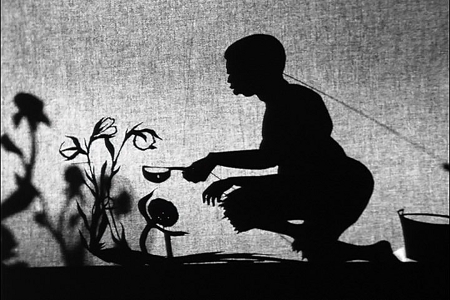INFORMATION - PEOPLE

“I became black in more senses than just the kind of multicultural acceptance that I grew up with in California. Blackness became a very loaded subject, a very loaded thing to be.”
In 1991 Walker received a BFA from Atlanta College of Art and in 1994 an MFA from Rhode Island School of Design where she began using silhouettes. During this time she also worked as a stripper, which Anne Leibovitz explains as an exploration into shame and exploitation. In an interview Walker explains “That put me back in my studio, trying to process and understand the shame and embarrassment” . Her first work was shown in New York in 1994: Gone: An Historical Romance of the Civil War As It Occurred Between the Dusky Thighs of One Young Negress and Her Heart. This tableaux depicted a dreamlike scene of mayhem, from a black man floating in the air due to his ballooned genitals, to a slave woman casually raising her leg to drop out babies, to a Southern belle with a mysterious extra pair of legs emerging from her skirt.
Following this she went on to win the John D and Catherine T MacArthur Foundation Achievement Award and ‘genius’ grant in 1997- making her the youngest person ever to do so. Her work has now been part of group exhibitions and formed solo exhibitions worldwide in venues such as the Museum of Modern Art, the Soloman R. Guggenheim Museum and the Whitney Museum of American Art. Furthermore she represented the US in the 2002 Sao Paulo Bienal in Brazil. In 2007 the first full-scale survey of Walker’s work entitled ‘My Complement, My Enemy, My Oppressor, My Love’ was exhibited containing over 200 pieces including examples of the variety of techniques she uses in her work and she also featured in the 2007 The Times Top 100 most influential people list.
Walker curated the exhibition 'After the Deluge' at the Metropolitan Museum of Art following Hurricane Katrina, where pieces of her own work were juxtaposed with others exploring the theme of water and the sea. She was inspired by the undercurrent issues of race in the aftermath, ‘I was seeing images that were all too familiar. It was black people in a state of life-or-death desperation, and everything corporeal was coming to the surface: water, excrement, sewage. It was a re-inscription of all the stereotypes about the black body’ .
Displayed at the Whitney Museum and recently at Tate Liverpool in the exhibition Afro-Modern: Journeys through the Black Atlantic was the video installation “8 Possible Beginnings or: The Creation of African-America, a Moving Picture by Kara E. Walker”. This is a typically problematic and yet compelling piece. The bizarre series of events, almost like a creation story, begins on a slave ship and involves a black male slave being impregnated by his master. At one point there is a clip of Walker’s daughter saying ‘I wish I was white’ playing repeatedly in the background.
Whilst Walker’s work, its techniques, motivations and manifestations, are interesting in themselves, what is equally important has been the many reactions to it. Alongside her great success Walker’s work has also provoked a very negative reaction in some quarters, particularly from certain older African American artists of the Civil Rights generation. Artist Betty Saar began a petition seeking to prevent Walker’s art from being exhibited, stating that the undersigned wanted “to spread awareness about the negative images produced by the young African-American artist, Kara Walker.” Many of Walker’s critics argue that her pieces are racist and offensive, a way to succeed in the white world. This argument is reminiscent of the controversy which surrounded the careers of figures such as Zora Neale Hurston and Claude McKay who did not conform to the ideas of Du Bois and the ‘’ elite who demanded blacks create only ‘positive’ images of African Americans. To this backlash Walker reacted in 1997 with the provocatively titled collection of drawings ‘Do You Like Creme in your Coffee and Chocolate in Your Milk?’. The work imagines conversations between herself and her critics posing questions such as “What, you want negative images of white people, positive images of blacks?” and continues the debate over the politics and representation of race.
Others have sought to defend Walker’s work and her right to create individually. Michelle Wallace, daughter of artist Faith Ringgold and author of Black Macho and The Myth of The Superwoman, argued in response to criticisms of Walker’s work, “This is about the work of Kara Walker and no one else, and certainly not about the collective race”. Richard Powell discussed the issue in ‘Black Art: A Cultural History’, he argued that ‘Walkers description of an illusionary yet phenomenological blackness may explain why such images are particularly incendiary for many African Americans who also sense the false nature of this version of blackness but cannot tolerate its physical portrayal .’ Hamza Walker similarly argues that the viewer should look to themselves rather than the artist, stating, ‘When art provokes anxiety ask why do you feel this way, instead of shifting the anxiety to the art.’
Walker’s work and views continue to cause debate and opposition. She has persistently pushed the boundaries of art and continues to challenge her own art with new techniques. She has begun to further layer the backgrounds of her work with silhouettes, most recently experimenting with the position of lighting in her exhibitions. This has added a new angle to her work by thrusting the viewers own shadow on to the scene, incorporating and immersing her audience into the experience of her art. Her work continues to challenge American history and conceptions of ‘race’, questioning not only what is acceptable within these loaded historic debates but challenging also what is acceptable to present in art.
Contributed by HGF
 |
Continue the debate on Kara Walker |
Return to People home